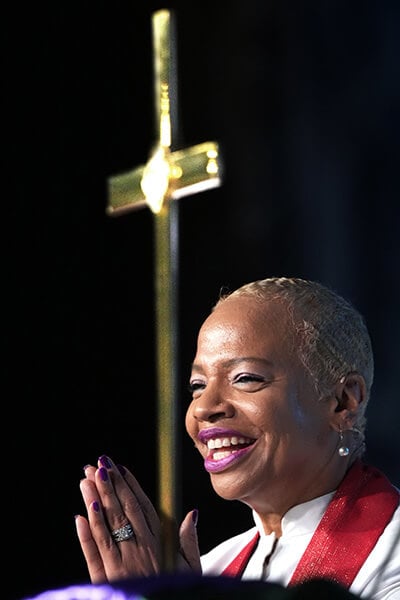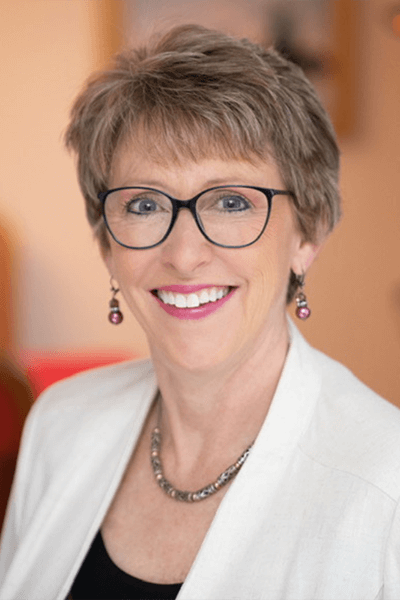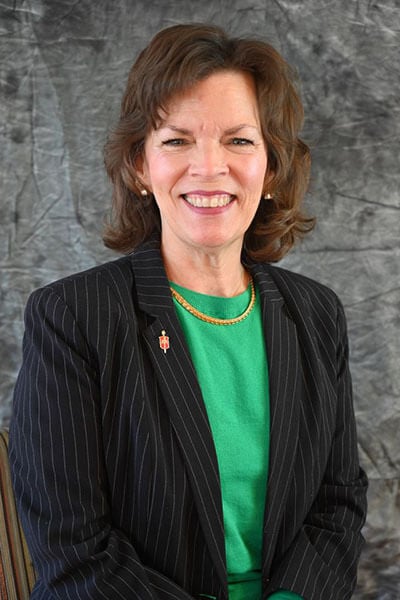Key points:
- A new vision statement for The United Methodist Church declares that United Methodists should love boldly, serve joyfully and lead courageously.
- In the Arkansas and Oklahoma conferences, advertising and social media campaigns are being prepared to propel that vision forward and spotlight the church’s values and resiliency.
- It’s time to leave distress over church disaffiliations behind, church leaders say.
It’s time for United Methodists to stride boldly, joyfully and courageously into the future, leaving behind any lingering disappointment and grief over church disaffiliations, church leaders say.
Two conferences — Oklahoma and Arkansas — aim to build on the new vision statement released by the Council of Bishops and Connectional Table in May with advertising and social media campaigns launching in the fall.
The vision statement: “The United Methodist Church forms disciples of Jesus Christ who, empowered by the Holy Spirit, love boldly, serve joyfully and lead courageously in local communities and worldwide connections.”

The new statement is meant to supplement, not replace, the denomination’s 30-year-old mission statement: “The mission of The United Methodist Church is to make disciples of Jesus Christ for the transformation of the world.”
The vision statement “has been received very, very well in the worldwide church,” said Indiana Conference Bishop Tracy S. Malone, who is also president of the Council of Bishops.
“We’ve done the soft launch,” she said. “I’m aware that there are clergy who are doing sermon series on the new vision statement, and even when I was just at the Mid Africa Central Conference (July meeting in Zambia), we shared the (promotional) video there in the midst of the elections.”
But if the message “doesn’t get into the pews, it’s just nice words on a page,” said Judi Kenaston, chief connectional ministries officer of the Connectional Table. The leadership body of lay and clergy acts as a sort of church council for the denomination, coordinating mission, ministry and resources.
“It’s got to get where people can internalize it and truly understand the vision,” Kenaston said. “I think it’s really important.”
Oklahoma and Arkansas are early adapters.
“Even amid the challenges we have faced as a church, I find a strong spirit shining out of the United Methodists of my three conferences,” said Bishop Laura Merrill, who oversees the Arkansas, Oklahoma and Oklahoma Indian Missionary conferences.
“It’s clear that they know God has put us here for a reason, and they want to be a part of making that purpose happen. These campaigns are a way for United Methodists to claim and proclaim that purpose and to invite others to be a part of a joyful, life-giving movement.”
It’s hoped that other conferences will support the vision statement in their own creative ways, Malone said.
“I think every bishop, every conference would need to do that so it’s not a cookie- cutter (rollout),” she said.

Poonam Patodia, chief marketing officer for United Methodist Communications, said the agency has ceased running national advertising campaigns because of budgetary constraints, but it remains important to keep the denomination’s positive perception high in the minds of those seeking a church home.
“It is encouraging to see individual annual conferences stepping in to help fill this important gap,” she said. “Keeping The United Methodist Church present where seekers are — and ensuring we are considered when people are searching for a faith community — remains vital.”
In Arkansas, United Methodist couple Rush and Linda Harding of Little Rock are financing an “identity campaign,” with the message of “Following Jesus, loving people and sharing grace.”
People in Arkansas can expect to see the message on billboards and online, said Amy Ezell, director of connectional ministries for the Arkansas Conference.
“When we heard the new vision statement, we just immediately could feel the Holy Spirit encouraging us that we are moving in the right direction,” Ezell said.
“The donors approached Bishop Merrill, reflecting the same feelings of wanting to reclaim our identity and promote who we are as core United Methodists in Arkansas.”
In Oklahoma, more than 500 people were surveyed about their expectations for the conference, and the idea for a public relations campaign was a frequent suggestion, said Carlos Ramirez, director of communications strategy for the conference.
“We want to tell the story to everybody about who we are as United Methodists in Oklahoma,” Ramirez said. “First and foremost, it is a marketing campaign to rebrand, to say, ‘This is who we are. Whatever you have heard before, this is who we are now.’”
The selected slogan was “What If Love,” without a question mark.
“It could be that it is an affirmation or a question, and everything in between,” Ramirez said. “It’s for the outsider to get to know us, to share who we are and the values we stand for. … It is what we’re living now as a conference, but also it’s aspirational.”

Details of how “What If Love” will be distributed are being worked out. Billboards, social media and television ads are under consideration. The conference has the resources to get it done, Ramirez said.
“The Oklahoma Conference has done a very good job of managing their legacy funds of churches that have closed, and we have also a lot of endowments that very generous brothers and sisters have left for us. So, it’s been well invested, so we have some funds there that we can reach out to.”
These campaigns and other strategies being planned will spotlight “the resiliency” that United Methodism has displayed during challenges like losing a quarter of U.S. churches in the leadup to the decision to more fully include LGBTQ people in the church, Malone said.
“There’s been great disappointment and congregations who are still grieving losing members and conferences losing churches,” Malone said. “But the church also found creative ways to reach new, younger and diverse people, such creative ways that many of those online and digital ministries are still moving forward.”
The bishop said there is “a renewed sense of purpose, a renewed sense of energy, a renewed sense of identity and direction and the church is already living forward.”
Patodia said it’s inspiring to see how well the conference-led campaigns align with the vision statement.
Subscribe to our
e-newsletter
“Campaigns like these not only extend our reach but can also serve as a healing journey for members within the conferences,” she added. “While the recent splintering did play out publicly, it’s important to remember that The United Methodist Church is so much more: a global community with a footprint that impacts lives around the world. That is the story we want to lift up.”
There is no “magic bullet” to please everyone about the direction of The United Methodist Church, Kenaston said.
“We’re not going to agree with everybody on everything, but we can still say we love each other boldly as well as loving others boldly and leading courageously,” she said.
“I hope that lets us feel a little bit better about who we are. We’ve had some rough years; there’s no question about that. But I feel like this vision does point us in a direction that will be good if we can go there.”
Ramirez said his campaign will be a success “if local congregations can catch on to this vision and create a fresh expression or a revitalization process.”
“Maybe for those churches who need it, they can catch the wind of the Spirit and start a process where they can prepare themselves for visitors, for starting something new.”
Patterson is a UM News reporter in Nashville, Tennessee. Contact him at 615-742-5470 or. To read more United Methodist news, subscribe to the free UM News Digests.





